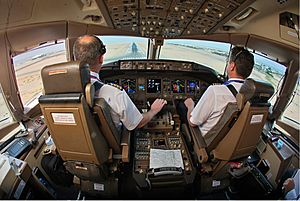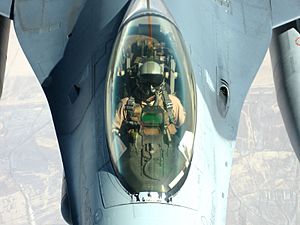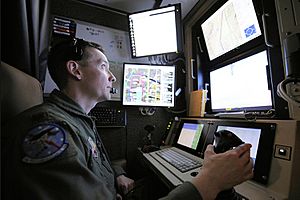Aircraft pilot facts for kids
An aircraft pilot, also known as an aviator, is the person who controls an aircraft's flight. They use special controls to steer the plane through the sky. Other crew members, like navigators who plan the route and flight engineers who check the engines, are also called aviators. However, people like flight attendants, mechanics, and ground crew are not considered aviators.
To show how skilled and important pilots are, many militaries and airlines give them special aviator badges to wear on their uniforms.
Contents
What's in a Name?
The word aviator was first used in 1887. It comes from the Latin word avis, which means "bird." In the early days of flying, when planes were new and exciting, people were called aviators. It sounded very brave and adventurous.
A long time ago, a female pilot was sometimes called an aviatrix, but this term is rarely used today. Now, we usually just say pilot for everyone who flies a plane. To fly an aircraft, a person must earn a pilot's license.
A Brief History of Pilots
When airplanes were first invented, flying was risky. To keep people safe, both in the air and on the ground, it quickly became clear that planes needed a trained and certified pilot in control. The pilot is responsible for making sure the flight is safe and follows all the rules.
The very first pilot certificate was given to Louis Blériot in France in 1908. Soon after, other countries like the United Kingdom and the United States began giving out pilot licenses too.
Civilian Pilots: Flying for Work and Fun

Civilian pilots fly many types of aircraft for different reasons. Some fly small planes for fun or for charity. Others fly for businesses, such as crop dusting on farms, fighting forest fires, or working for law enforcement.
Many pilots fly for airlines, carrying passengers and cargo all over the world. When flying for an airline, the main pilot is often called the captain.
Airline Pilots
In 2017, there were about 290,000 airline pilots worldwide. Experts believe that by 2027, another 255,000 new pilots will be needed. This is because more people are traveling by plane and many older pilots are retiring. The biggest need for new pilots is in the Asia-Pacific region, followed by the Americas and Europe.
Because there is a high demand for pilots, some are leaving jobs in corporate aviation to fly for major airlines. This shows that being an airline pilot is a popular and important career.
The Future: Will Planes Fly Themselves?
The number of pilots needed might change in the future because of automation. Some experts think that technology could one day replace co-pilots, or even all pilots on a plane. This is sometimes called "pilotless" or "autonomous" flight.
In 2017, the owner of Diamond Aircraft said that companies are working on single-pilot planes that could be controlled from the ground. He thought this could happen for cargo planes in the near future.
Some studies suggest that pilotless airliners could save companies a lot of money, mostly in pilot salaries and training. However, many people are not yet comfortable with the idea of flying on a plane with no pilot. A survey showed that 54% of people would not want to fly on a pilotless plane.
For now, automated systems on planes still need to be watched by human pilots. Creating a truly self-flying plane would require advanced artificial intelligence (AI) that can be proven to be safe. It is more likely that we will first see cargo planes with a single pilot before we see passenger planes without any pilots.
Military Pilots
Military pilots fly for the armed forces of a country, like an air force or a navy. Their job can involve combat missions or non-combat tasks, such as transporting soldiers and supplies. Military pilots go through special training to learn how to fly advanced aircraft and often use weapons.
Examples of military pilots include:
- Fighter pilots who fly fast jets in combat.
- Bomber pilots who fly planes that drop bombs.
- Transport pilots who fly large planes to move troops and equipment.
- Test pilots who fly brand-new aircraft to see how well they work.
- Astronauts who are often chosen from the ranks of military pilots.
Military pilot training is different from civilian training because the aircraft and missions are very different. Many military pilots later get civilian pilot licenses and fly for airlines after they leave the military.
The world's first bombing missions happened during World War I. In 1914, French and British pilots flew missions to attack enemy targets. At first, the bombs were very simple and were just thrown out of the plane by the crew. This was the beginning of using aircraft in warfare.
Drone Pilots
Unmanned aerial vehicles (UAVs), often called "drones," are aircraft that fly without a pilot on board. There are two main types:
- Autonomous drones fly on their own without a human controlling them during the flight.
- Remotely piloted drones are flown by a person on the ground using a controller.
The person who flies a remotely piloted drone is often called its pilot or operator. These pilots may need special training, but they usually don't need the same kind of license as a pilot of a regular airplane. The use of drones is growing quickly, and there will likely be a high demand for drone pilots in the future.
Pilots in Space
The idea of a pilot also applies to human spaceflight. An astronaut who controls a spacecraft is called a pilot. This person is responsible for steering the spacecraft and making sure it operates correctly, just like an airplane pilot.
How to Become a Pilot

Becoming a pilot requires many hours of flight training and studying. The rules for becoming a pilot are different in each country.
The first step is usually to get a Private Pilot License (PPL). In the United States, this requires at least 35 to 40 hours of flight training with a certified instructor. After getting a PPL, a pilot can learn to fly in difficult weather by getting an Instrument Rating (IR) or learn to fly planes with more than one engine.
To get paid for flying, a pilot needs a Commercial Pilot License (CPL). To become an airline captain, a pilot must earn an Airline Transport Pilot License (ATPL), which is the highest level of pilot certificate.
Pilot Licensing Around the World
Canada
In Canada, flying is regulated by the Aeronautics Act. The rules for getting a pilot's license are listed in the Canadian Aviation Regulations. The retirement age for pilots can be different at each airline.
United States
In 2020, there were over 690,000 active pilots in the United States. This includes student pilots, private pilots, and professional airline pilots. The rules for pilot licenses were first set up in 1930. Commercial airline pilots in the U.S. must retire by age 65.
See also
 In Spanish: Piloto de aviación para niños
In Spanish: Piloto de aviación para niños
- Airline pilot uniforms
- Air safety
- IMSAFE (a way for pilots to check if they are fit to fly)
- List of aerospace engineers
- List of aviators
- Pilot fatigue
- Pilot logbook






